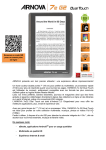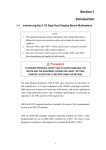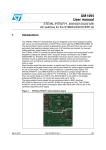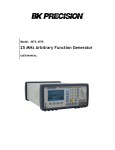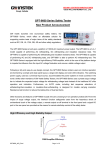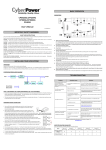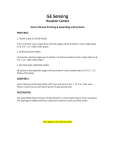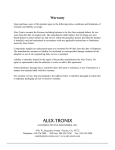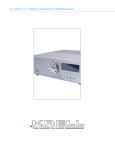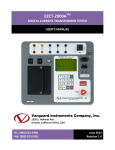Download IRM-5000P - Vanguard Instruments Company, Inc.
Transcript
IRM-5000PTM INSULATION RESISTANCE METER USER’S MANUAL Vanguard Instruments Company, Inc. 1520 S. Hellman Ave. Ontario, California 91761, USA TEL: (909) 923-9390 FAX: (909) 923-9391 May 2010 Revision 2 IRM-5000P USER’S MANUAL REV 2 SAFETY SUMMARY FOLLOW EXACT OPERATING PROCEDURES Any deviation from the procedures described in this User’s Manual may create one or more safety hazards, may damage the IRM-5000P, or cause errors in the test results. Vanguard Instruments Company, Inc. assumes no liability for unsafe or improper use of the IRM-5000P. All safety precautions provided in this manual must be observed during all phases of testing including test preparation, test lead connection, actual testing, and test lead disconnection. SAFETY WARNINGS AND CAUTIONS All devices under test shall be off-line and fully isolated. The area around the IRM-5000P’s charging circuits and test terminals must be kept clean and dry to prevent high-voltage leakage paths which can cause hazardous conditions or erroneous measurements. Failure to heed these precautions may result in unsafe operating conditions, cause erroneous test results, and will void the manufacturer’s warranty. DO NOT MODIFY TEST EQUIPMENT To avoid the risk of introducing additional or unknown hazards, do not install substitute parts or perform any unauthorized modification to any IRM-5000P test unit. To ensure that all designed safety features are maintained, it is highly recommended that repairs be performed only by Vanguard Instruments Company factory personnel or by an authorized repair service provider. Unauthorized modifications can cause safety hazards and will void the manufacturer’s warranty. WARNING Do not remove test leads during a test. Failure to heed this warning can result in electrical shock to personnel and damage to the equipment. i REV 2 IRM-5000P USER’S MANUAL TABLE OF CONTENTS CONVENTIONS USED IN THIS DOCUMENT ..................................................................................... 1 1.0 INTRODUCTION .................................................................................................................... 2 1.1 General Description and Features ................................................................................... 2 1.2 Furnished Accessories ...................................................................................................... 4 1.3 Technical Specifications ................................................................................................... 5 1.4 IRM-5000P Controls and Indicators ................................................................................. 6 2.0 PRE-TEST SETUP ................................................................................................................... 8 2.1 Operating Voltages .......................................................................................................... 8 2.2 LCD Screen Contrast Control............................................................................................ 9 2.3 Printer Paper Control ....................................................................................................... 9 2.4 Printer Paper .................................................................................................................... 9 3.0 OPERATING PROCEDURES ................................................................................................. 11 3.1 Performing Tests ............................................................................................................ 11 3.1.1. Entering Test Record Header Information ............................................................. 11 3.1.2. Performing an Insulation Resistance Test .............................................................. 14 3.1.3. Performing a Polarization Index Ratio (PI) Test ..................................................... 22 3.1.4. Performing a Step Voltage (SV) Test ...................................................................... 28 3.1.5. Performing a Dielectric Discharge (DD) Test .......................................................... 34 3.2 Working With Test Records ........................................................................................... 40 3.2.1. Saving a Test Record............................................................................................... 40 3.2.2. Restoring a Test Record From Flash EEPROM ........................................................ 41 3.2.3. Printing a Test Record from the Working Memory ................................................ 42 3.2.4. Printing a Directory of Test Records Stored in the IRM-5000P’s Memory ............ 44 3.2.5. Erasing Test Records From the Flash EEPROM ...................................................... 46 4.0 CHANGING SETUP PARAMETERS ....................................................................................... 48 4.1 Setting the Clock ............................................................................................................ 48 4.2 Setting the Frequency .................................................................................................... 49 4.3 Setting the Temperature Units of Measure................................................................... 50 4.4 Enabling the Computer Interface .................................................................................. 51 APPENDIX A - DIELECTRIC DISCHARGE RATIO TEST DESCRIPTION ............................................... 52 APPENDIX B - GUARD TERMINAL APPLICATION ........................................................................... 53 ii IRM-5000P USER’S MANUAL REV 2 LIST OF TABLES Table 1. IRM-5000P Technical Specifications ................................................................................. 5 Table 2. Functional Descriptions of IRM-5000P Controls and Indicators ....................................... 7 Table 3. Voltage Selection Jumper Settings .................................................................................... 8 Table 4. PI Ratio Table................................................................................................................... 27 LIST OF FIGURES Figure 1. IRM-5000P Controls and Indicators ................................................................................. 6 Figure 2. 100-120 Vac Jumper Settings........................................................................................... 8 Figure 3. 200-240 Vac Jumper Settings........................................................................................... 8 Figure 4. Resistance Test Results Report Printout ........................................................................ 20 Figure 5. Resistance Plot from a Resistance Test ......................................................................... 20 Figure 6. Current Plot from a Resistance Test .............................................................................. 21 Figure 7. Polarization Index Test Results Report Printout ............................................................ 26 Figure 8. Polarization Index Test Resistance Plot ......................................................................... 27 Figure 9. Polarization Index Test Current Plot .............................................................................. 27 Figure 10. Step Voltage Test Results Report Printout .................................................................. 32 Figure 11. Step Voltage Test Resistance and Current Plots .......................................................... 33 Figure 12. Dielectric Discharge Test Results Report Printout ....................................................... 37 Figure 13. Dielectric Discharge Test Resistance Plot .................................................................... 38 Figure 14. Dielectric Discharge Test Current Plot ......................................................................... 39 Figure 15. Typical Test Record Directory Printout ........................................................................ 45 iii REV 2 IRM-5000P USER’S MANUAL CONVENTIONS USED IN THIS DOCUMENT This document uses the following conventions: • A key or switch on the IRM-5000P is indicated as [KEY] and [SWITCH]. • Menu options are referenced as (MENU OPTION). • Screen and menu names are referenced as “SCREEN/MENU NAME”. • The terms “test record” and “test shot” are used interchangeably. • IRM-5000P LCD screen output is shown as: 1. OPTION 2. OPTION 3. OPTION 4. OPTION • When instructions are provided, the menu item that should be selected is shown in bold as shown below (option 3 should be selected): 1. OPTION 2. OPTION 3. OPTION 4. OPTION • 1 2 3 4 1 2 3 4 Warning messages are indicated as: Warning message WARNING • Important notes are indicated as: Note details NOTE 1 IRM-5000P USER’S MANUAL 1.0 INTRODUCTION 1.1 General Description and Features REV 2 The IRM-5000P is a microprocessor-based, high-voltage, insulation-test ohmmeter. The rugged and portable IRM-5000P is ideal for use in electric utility substations and for industrial applications. This sophisticated insulation tester uses a dual-microprocessor design. One microprocessor is dedicated to the control of the power supply and measuring circuitry, while the second is dedicated to the user interfaces and printer control. To ensure operator safety, the microprocessors communicate via an optical link, thus isolating the operator controls from the dangerous high test voltages inside the unit. The IRM-5000P measures the insulation resistance of a test material by applying a known test voltage and measuring the resultant leakage current. The measured insulation resistance is then displayed on the back-lit LCD screen. The IRM-5000P’s built-in 2.5-inch wide thermal printer can print test reports in both tabular and graphic formats. Up to 100 test reports can be stored in the unit’s internal memory. Test reports can also be transferred to a PC via the built-in RS-232C interface. The IRM-5000P can automatically perform industry-standard tests such as Polarization Index (PI) test, Step Voltage (ST) test, and Dielectric Discharge (DDS) test. Test Voltage The IRM-5000P can perform tests with preset voltages (500, 1000, 2500, 5000 Vdc), or with user-selectable voltages ranging from 50 Vdc to 5000 Vdc with a ±2 Vdc resolution. Insulation Resistance Test The test voltage for an insulation resistance test can be user-selected, and the test duration can range from 1 to 90 minutes. The IRM-5000P will then collect resistance readings throughout the selected test period. The resistance value, test voltage, leakage current, and capacitance are displayed on the back-lit LCD screen. The tabulated test report can be printed on the built-in 2.5-inch wide thermal printer. The report can also be printed as a graph of the resistance over time. Polarization Index (PI) Test The Polarization Index (PI) measures the ratio of insulation resistance after one minute and then after ten minutes. The Polarization Index is derived from a ratio of the two periods, where the resistance value at ten minutes is divided by the resistance value at one minute. PI tests can be run at preset voltages (500, 1000, 2500, 5000 Vdc) or at a user-specified voltage from 50 Vdc to 5000 Vdc. Test results can be printed in both tabular and graphic formats. Step Voltage (SV) Test The Step Voltage test is based on an ideal insulator producing the same resistance measurement at all voltages. As an example, an insulator that is over-stressed will measure lower resistance values at higher voltages. Accordingly, the resistances measured on an overstressed insulator at increasingly higher voltages (steps) will produce decreasingly lower resistance values. 2 REV 2 IRM-5000P USER’S MANUAL The SV test measures insulation resistances in five equal voltage steps up to a final test voltage of 2500 Vdc or 5000 Vdc. The voltage is stepped up in 1/5 increments of the final test voltage every one minute, five minutes, or other user-defined time interval. Dielectric Discharge (DDS) Test The DDS test measures the dielectric absorption of an insulator. This test can be used to diagnose an insulation problem in cases where multi-layered insulation is used. The default test requires 30 minutes of applying full voltage followed by a one minute discharging of the Device Under Test (DUT). The DD value is then calculated using the formula: DD Ratio = Current after 1 minute (mA) / (Test Voltage X Capacitance) Capacitor Discharge After each test, the IRM-5000P automatically discharges any test voltage left on the test material. An audible alarm and a message on the screen warn the operator of the shock hazard during each discharging period. Capacitance Display The IRM-5000P automatically measures the capacitance of the device being tested. The capacitance-measuring range is from 0.01 µF to 10.0 µF. Volt Meter The IRM-5000P can also be used to measure voltages. Measurable input voltage ranges from 50 V to 1250 V, AC or DC. User Interface The IRM-5000P features a back-lit LCD screen (20 characters by 4 lines) that is viewable in both bright sunlight and low-light levels. A rugged, 16-key, membrane keypad is used to control the unit. Built-in Thermal Printer The IRM-5000P’s built-in 2.5-inch wide thermal printer can print the test reports in both tabular and graphic formats. Internal Test Record Storage The IRM-5000P can store up to 100 test records in Flash EEPROM. Test records can be retrieved and printed on the built-in thermal printer, or they can be transferred to a PC via the unit’s RS232C interface. Computer Interface The IRM-5000P can be computer-controlled via its RS-232C interface. A Windows® XP/Vistabased analysis software application is provided with each unit. Using this software, test records can be retrieved from the IRM-5000P and then stored on the PC for future analysis and report generation. A special feature of the software can overlay several resistance curves on-screen and can be used to monitor the resistance deterioration of a test material over time. Additionally, test records can be exported in Microsoft® Excel format for further analysis. 3 IRM-5000P USER’S MANUAL REV 2 Temperature Probe A non-contacting, infrared, temperature sensor is provided with each unit for recording test material temperatures. Power Source The IRM-5000P can operate continually for up to 6-hours using its internal rechargeable SLA batteries, or it can be operated with an external power source. 1.2 Furnished Accessories The IRM-5000P comes furnished with the following: • • • • • One 6-foot cable set One 15-foot cable set One RS-232C Cable One power cord Cable carrying duffel bag 4 REV 2 1.3 IRM-5000P USER’S MANUAL Technical Specifications Table 1. IRM-5000P Technical Specifications TYPE Insulation resistance meter PHYSICAL SPECIFICATIONS 19”W x 7”H x 15”D, (48 cm x 17 cm x 38 cm); Weight: 24lbs (10.9 kg) INPUT POWER 100 – 120 Vac or 220 – 240 Vac (selectable), 50/60Hz RESISTANCE READING 100 K-ohms – 1 M-ohm ±20%, RANGE 1 M-ohm – 1 T-ohm ±5%, (0°C to +30°C) 1 T-ohm – 5 T-ohm ±20% , 5kV 100 K-ohms – 1 M-ohm ±20%, 1 M-ohm – 100 G-ohms ±5%, 100 G-ohms – 500 G-ohms ±5%, 500 V 1 M-ohm – 10 G-ohms ±5%, 50 V TEST VOLTAGE Selectable from 50Vdc – 5 KVdc, in 2 Vdc steps OUTPUT VOLTAGE ±2%, ±1v of selected voltage with load resistance greater than 100 MΩ ACCURACY (0°C to +30°C) SHORT CIRCUIT CURRENT 2 mA max CURRENT READING RANGE 0.03 nA – 2 mA; Accuracy: ±5% ±0.2 nA (0°C to +30°C) CAPACITANCE READING 0.01 μF – 10.0 μF (Test voltage greater than 100V); Accuracy: ±5% ±0.03 μF RANGE (0°C to +30°C) VOLTAGE READING RANGE 50 – 1250 Vac (rms) or dc; Accuracy: ±5%, ±1V (0°C to +30°C) CAPACITOR DISCHARGE Less than 2 Sec/μF, automatic at the end of test HUM REJECTION 1mA per 1kv of test voltage, 2mA rms maximum BATTERIES Two 12V, 2.0 Ah sealed lead acid batteries. Battery life: typical 6 hrs, continuous testing. The IRM-5000P can be used while charging. PRINTER COMPUTER INTERFACE Built-in 2.5-inch wide thermal printer can print test results in both tabulated and graphic formats One RS-232C port INTERNAL TEST RECORD Store up to 100 test records in Flash EEPROM STORAGE SAFETY UL Certified (UL 61010A-1), CAN/CSA Certified (C22.2 No. 1010.1-92) ENVIRONMENT Operating: -10˚ to 50˚ C (15˚ to +122˚ F); Storage: -30˚ C to 70˚ C (-22˚ to +158˚ F) HUMIDITY (MAX) 90% RH @ 40˚ C (104˚ F) non-condensing ALTITUDE (MAX) 2000m (6562 ft) to fully safety specifications CABLES One 6-foot cable set, one 15-foot cable set, ground cable, power cord, cable bag OPTIONS Transportation Case WARRANTY One year on parts and labor The above specifications are valid at nominal operating voltage and at a temperature of 25°C (77°F). Specifications may change without prior notice. NOTE 5 IRM-5000P USER’S MANUAL 1.4 REV 2 IRM-5000P Controls and Indicators The IRM-5000P’s controls and indicators are shown in Figure 1 below. A leader line with an index number points to each control and indicator, which is cross-referenced to a functional description in Table 2. The table describes the function of each item on the control panel. The purpose of the controls and indicators may seem obvious, but users should become familiar with them before using the IRM-5000P. Accidental misuse of the controls will usually cause no serious harm. Users should also be familiar with the safety summary found on the front page of this User’s Manual. Figure 1. IRM-5000P Controls and Indicators 6 REV 2 IRM-5000P USER’S MANUAL Table 2. Functional Descriptions of IRM-5000P Controls and Indicators Item Number Panel Markings 1 RS-232C 110-120 Vac, 2A, 50-60Hz Fuse: 250Vac, 3A Fast-Blow Power plug and fuse holder. 2 3 HIGH VOLTAGE PRESENT Test voltage presence indicator. 4 CHARGE POWER Battery charging indicator. Power switch. Back-lit LCD Screen (20 characters by 4 lines). Viewable in both bright sunlight and low-light levels. 7 Rugged alpha-numeric keypad. 8 7 RS-232C PC interface. Built-in 2.5-inch wide thermal printer. 5 6 Functional Description 9 NEG Negative test lead terminal. 10 GUARD Guard test lead terminal. 11 POS Positive test lead terminal. IRM-5000P USER’S MANUAL 2.0 PRE-TEST SETUP 2.1 Operating Voltages REV 2 The IRM-5000P’s operating voltage is preset at the factory and is selectable between 100-120 Vac, 50/60 Hz or 200-240 Vac, 50/60 Hz. The voltage is set by placing jumpers at the JP16 and J1 jumper blocks on the main board as listed in Table 3 and illustrated in Figure 2 and Figure 3. Table 3. Voltage Selection Jumper Settings J1 Settings Voltage Selection JP16 Settings 100 – 120 Vac Jumper Pin 1 and 2 Jumper Pin 3 and 4 Jumper Pin 1 and 2 Jumper Pin 3 and 4 200 – 240 Vac Jumper Pin 2 and 3 Jumper Pin 2 and 3 Figure 2. 100-120 Vac Jumper Settings Figure 3. 200-240 Vac Jumper Settings 8 REV 2 2.2 IRM-5000P USER’S MANUAL LCD Screen Contrast Control To increase the LCD screen contrast, press and hold the [PAPER ∧ Contrast] key for two seconds. Release the button when the desired contrast level has been reached. To decrease the LCD screen contrast, press and hold the [PAPER ∨ Contrast] key for two seconds. Release the button when the desired contrast level has been reached. 2.3 Printer Paper Control To advance the thermal printer paper, press and release the [PAPER ∧ Contrast] key. To retract the thermal printer paper, press and release the [PAPER ∨ Contrast] key. 2.4 Printer Paper The IRM-5000P’s built-in thermal printer uses 2.5-inch wide thermal paper for printing test results. To maintain the highest print quality and to avoid paper jams, the use of thermal paper supplied by Vanguard Instruments Company is highly recommended. Additional paper can be ordered from the following sources: Vanguard Instruments Co, Inc. 1520 S. Hellman Avenue Ontario, CA 91761 Tel: 909-923-9390 Fax: 909-923-9391 Part Number: VIC TP-3 paper BG Instrument Co. 13607 E. Trent Avenue Spokane, WA 99216 Tel: 509-893-9881 Fax: 509-893-9803 Part Number: VIC TP-3 paper 9 IRM-5000P USER’S MANUAL 2.5 REV 2 Replacing the Thermal Printer Paper The roll of thermal paper is housed inside a dispenser underneath the printer cover. To replace the paper, follow the steps below: • • • • • • • Unscrew the two large printer cover screws and remove the printer cover. Remove the leftover thermal paper roll from the paper holder. Unroll the new thermal paper roll. Feed the thermal paper into the slot between the paper pocket and the rubber roller. The printer will automatically pull the paper under the thermal head. Place the paper roll into the paper holder. Lift the thermal head and align the thermal paper if necessary. Re-install the printer cover. NOTE Thermal paper has a chemical coating on one side of the paper. This side should be facing the thermal print head. Incorrect paper loading may result in blank output on the thermal paper. The thermal paper will show a red stripe to indicate that the roll is about to run out of paper. 10 REV 2 IRM-5000P USER’S MANUAL 3.0 OPERATING PROCEDURES 3.1 Performing Tests 3.1.1. Entering Test Record Header Information You can enter the test record header information before performing tests. The record header includes identifying information such as company, location, test description, etc. Once the header information has been entered, it will apply to all subsequent test records. To enter the header information: a. When the unit is turned on, you will be presented with the “START-UP” menu: 1. RUN TEST 05/05/10 2. UTILITIES 10:10:15 Bat: TERMINAL VTG: 1 V • NOTES If the IRM-5000P is running on battery power, the battery icon will be displayed on the LCD screen as shown above. The icon also represents the charge level of the battery. If the IRM-5000P is plugged in, a plug icon will be displayed on the LCD screen as shown below: 1. RUN TEST 05/05/10 2. UTILITIES 10:10:15 Bat: TERMINAL VTG: 1 V • The test terminal voltage is displayed at the bottom of the LCD screen. The IRM-5000P can be used as a voltmeter by connecting the positive and negative leads to a voltage source. The voltage measurement range is from 50-1250 V(AC/DC). Press the [2] key (UTILITIES). b. The following screen will be displayed: 1.PRINT 3.SETUP 2.SAVE/RES TERMINAL VTG: Press the [3] key (SETUP). 11 1 V IRM-5000P USER’S MANUAL REV 2 c. The following screen will be displayed: 1.TEST ID 2.CLOCK 3.COMP INT 4.50/60Hz 5.°C/°F TERMINAL VTG: 1 V Press the [1] key (TEST ID). d. The following screen will be displayed: COMPANY _ ENTER to Confirm TERMINAL VTG: 1 V Type the company name using the alpha-numeric keypad. When pressing a key, the corresponding number on the key will be displayed first. Pressing the key again will display the first letter on the key. Pressing the key again will display the second letter on the key. For example, to type the letter “A”, you must press the [2] key twice. To erase the character at the cursor position, press the [CLEAR] key. Press the [PAPER ∧ Contrast] key to move to the next character. Press the [PAPER ∨ Contrast] key to move to the previous character. Press the [ENTER] key when you are done typing the company name. e. The following screen will be displayed: LOCATION _ ENTER to Confirm TERMINAL VTG: 1 V Type the location name using the alpha-numeric keypad and then press the [ENTER] key. f. The following screen will be displayed: TEST DESCRIPTION _ ENTER to Confirm TERMINAL VTG: 1 V Type the test description using the alpha-numeric keypad and then press the [ENTER] key. g. The following screen will be displayed: 12 REV 2 IRM-5000P USER’S MANUAL OPERATOR _ ENTER to Confirm TERMINAL VTG: 1 V Type the operator’s name using the alpha-numeric keypad and then press the [ENTER] key. All header information will be saved, and you will be returned to the “START-UP” menu. 13 IRM-5000P USER’S MANUAL REV 2 3.1.2. Performing an Insulation Resistance Test The insulation resistance test measures the insulation resistance at selected voltages. Since the insulation resistance is continuously monitored during each test, users can plot the resistance or current values versus time. Use the steps below to perform an insulation resistance test: a. Start from the “START-UP” menu: 1. RUN TEST 05/05/10 2. UTILITIES 10:10:15 Bat: TERMINAL VTG: 1 V Press the [1] key (RUN TEST). If you had previously performed a test and had not saved the test results, the following screen will be displayed: NOTE Test Not Saved! “Enter” To continue TERMINAL VTG: 1 V Press the [ENTER] key if you do not want to save the results from the previous test. Continue to step b. Press any other key if you would like to save the results from the previous test. You will be returned to the “START-UP” menu. Please see section 3.2.1 for instructions on how to save test results to the IRM-5000P’s Flash EEPROM. b. The following screen will be displayed: 1. R 3. DD TERMINAL VTG: 2. PI 4. SV 1 V Press the [1] key (R). 14 REV 2 IRM-5000P USER’S MANUAL c. The following screen will be displayed: 1. 1 Min 3. 30 Min 2. 10 Min 4. Custom TERMINAL VTG: 1 V 1. 1 Min Press the [1] key to select the 1 minute test duration. Continue to step d. 2. 10 Min Press the [2] key to select the 10 minute test duration. Continue to step d. 3. 30 Min Press the [3] key to select the 30 minute test duration. Continue to step d. 4. Custom Press the [4] key to enter a custom test duration in minutes. The following screen will be displayed: Test Time (Minutes): 0 Minutes TERMINAL VTG: 1 V Type the desired test duration in minutes using the numeric keypad, and then press the [ENTER] key. Continue to step d. d. The following screen will be displayed: 1. 500V 2. 1000V 3. 2500V 4. 5000V 5. Custom TERMINAL VTG: 1 V 1. 500V Press the [1] key to select 500V for the test voltage. Continue to step e. 2. 1000V Press the [2] key to select 1000V for the test voltage. Continue to step e. 3. 2500V Press the [3] key to select 2500V for the test voltage. Continue to step e. 4. 5000V Press the [4] key to select 5000V for the test voltage. Continue to step e. 15 IRM-5000P USER’S MANUAL REV 2 5. Custom Press the [5] key to enter a custom test voltage value. The following screen will be displayed: Test Voltage (50-5K) 0 Volts TERMINAL VTG: 1 V Type the desired test voltage (between 50 V – 5000 V) using the numeric keypad, and then press the [ENTER] key. Continue to step e. e. The following screen will be displayed: ENTER D.U.T. TEMP? 1. YES 2. NO TERMINAL VTG: 1 V 1. YES Press the [1] key (YES) if you would like to enter the Device Under Test (D.U.T.) temperature. The following screen will be displayed: ENTER TEMP (0-254 F) °F TERMINAL VTG: 1 V Type the D.U.T. temperature using the numeric keypad. The screen will be updated as shown: ENTER TEMP (0-254 F) 120 °F TERMINAL VTG: 1 V Press the [ENTER] key and continue to step f. 2. NO Press the [2] key (NO) if you do not want to enter the Device Under Test (D.U.T.) temperature. Continue to step f. 16 REV 2 IRM-5000P USER’S MANUAL f. The following screen will be displayed: PRINT DURING TEST? 1. YES 2. NO TERMINAL VTG: 1 V 1. YES Press the [1] key (YES) to print the resistance readings on the IRM-5000P’s builtin thermal printer. If this option is selected, the resistance values will be printed at every second, starting at 10 seconds. Continue to step g. 2. NO Press the [2] key (NO) if you do not want to print the resistance readings. Continue to step g. g. The following screen will be displayed if the IRM-5000P needs to perform selfcalibration: CALIBRATING PLEASE WAIT 25 TERMINAL VTG: 1 V The remaining calibration time is displayed in seconds. When the calibration is completed, the following screen will be displayed: “ENTER” TO START! R 5000V 10Min TERMINAL VTG: 1 V Press the [ENTER] key to start the test. h. The following screen will be displayed while the test is being performed: Bat: Time: 09:51 Resistance: 983.8 M Current: 47 uA TEST VOLTAGE: 4999V The resistance value symbols are: T = Tera-ohm G = Giga-ohm NOTE M = Mega-ohm K = Kilo-ohm 17 IRM-5000P USER’S MANUAL REV 2 The LCD screen will be dynamically updated displaying the remaining time along with the resistance, current, and test voltage values. When the test is completed, the results will be displayed as shown: Res=989.7M 5000V 0.0uF 4.87uA 10:00 TERMINAL VTG: 1 V Press any key to continue. If you had entered a D.U.T. temperature in step e, the following screen will be displayed: NOTE D.U.T. TEMP: 200°F EQ R @ 40°C: 399.6G TERMINAL VTG: 1 V This screen shows the equivalent resistance value at 40°C. The equivalent resistance value is automatically calculated by the IRM-5000P based on the D.U.T. temperature entered in step e. Press any key to continue. The following screen will be displayed: D.U.T. TEMP: 200°F EQ R @ 20°C: 1.599T TERMINAL VTG: 1 V This screen shows the calculated equivalent resistance value at 20°C. Press any key to continue. i. The following screen will be displayed: PRINT REPORT? 1.YES 2.NO TERMINAL VTG: 1 V Press the [1] key (YES) to print the test report (See Figure 4 for a sample test report printout). j. The test report will be printed on the built-in thermal printer, and then the following screen will be displayed: 18 REV 2 IRM-5000P USER’S MANUAL SAVE TEST? 1.YES 2.NO TERMINAL VTG: 1 V Press the [1] key (YES) to save the test results. k. The following screen will be displayed: TEST NUMBER 1 HAS BEEN SAVED! TERMINAL VTG: 1 V Press any key to continue. l. The following screen will be displayed: REPEAT TEST? 1.YES 2.NO TERMINAL VTG: 1 V Press the [2] key (NO). You will be returned to the “START-UP” menu. Please see section 3.2.3 for instructions on how to print test results graphs. NOTE 19 IRM-5000P USER’S MANUAL REV 2 Figure 4. Resistance Test Results Report Printout Figure 5. Resistance Plot from a Resistance Test 20 REV 2 IRM-5000P USER’S MANUAL Figure 6. Current Plot from a Resistance Test 21 IRM-5000P USER’S MANUAL REV 2 3.1.3. Performing a Polarization Index Ratio (PI) Test The polarization index (PI) is derived from the ratio of the insulation resistance at ten minutes divided by the insulation value at one minute. For a typical insulation, the resistance value increases as time increases during a test. Standard voltages of 500 V, 1000 V, or 5000 V can be used, or the user can enter a custom test voltage value from 50 V to 5000 V. The default test duration is ten minutes, but a custom test duration can be set from 10 to 99 minutes. Follow the steps below to perform a PI test: a. Start from the “Start-Up” menu: 1. RUN TEST 05/05/10 2. UTILITIES 10:10:15 Bat: TERMINAL VTG: 1 V Press the [1] key (RUN TEST). b. The following screen will be displayed: 1. R 3. DD 2. PI 4. SV TERMINAL VTG: 1 V Press the [2] key (PI). c. The following screen will be displayed: 1. 10 Min (Default) 2. Custom TERMINAL VTG: 1 V 1. 10 Min (Default) Press the [1] key to select the default test duration of 10 minutes. Continue to step d. 2. Custom Press the [2] key to enter a custom test duration (between 10 to 99 minutes). The following screen will be displayed: NON-STANDARD Time? “ENTER” to continue TERMINAL VTG: 1 V Press the [ENTER] key to continue. 22 REV 2 IRM-5000P USER’S MANUAL If you press any other key besides the [ENTER] key, you will be returned to the beginning of step c. NOTE The following screen will be displayed: Test Time (Minutes): 0 Minutes TERMINAL VTG: 1 V Enter the test duration using the numeric keypad and then press the [ENTER] key. Continue to step d. d. The following screen will be displayed: 1. 500V 2. 1000V 3. 2500V 4. 5000V 5. Custom TERMINAL VTG: 1 V Select the desired test voltage by pressing the corresponding key ([1], [2], [3], [4], or [5]). e. The following screen will be displayed: ENTER D.U.T. TEMP? 1. YES 2. NO TERMINAL VTG: 1 V 1. YES Press the [1] key (YES) if you would like to enter the Device Under Test (D.U.T.) temperature. The following screen will be displayed: ENTER TEMP (0-254 F) °F TERMINAL VTG: 1 V Type the D.U.T. temperature using the numeric keypad. The screen will be updated as shown: ENTER TEMP (0-254 F) 120 °F TERMINAL VTG: 1 V Press the [ENTER] key and continue to step f. 23 IRM-5000P USER’S MANUAL REV 2 2. NO Press the [2] key (NO) if you do not want to enter the Device Under Test (D.U.T.) temperature. Continue to step f. f. The following screen will be displayed: PRINT DURING TEST? 1. YES 2. NO TERMINAL VTG: 1 V 1. YES Press the [1] key (YES) to print the resistance readings on the IRM-5000P’s builtin thermal printer. If this option is selected, the resistance values will be printed at every second, starting at 10 seconds. Continue to step g. 2. NO Press the [2] key (NO) if you do not want to print the resistance readings. Continue to step g. g. The following screen will be displayed: CALIBRATING PLEASE WAIT 25 TERMINAL VTG: 1 V The IRM-5000P will perform self-calibration, and then the following screen will be displayed: “ENTER” TO START! PI 350V 10Min TERMINAL VTG: 1 V Press the [ENTER] key to start the test. h. The following screen will be displayed while the test is being performed: Bat: Time: 09:43 Resistance: 2.517 M Current: 98.16 uA TEST VOLTAGE: 350 V 24 REV 2 IRM-5000P USER’S MANUAL The LCD screen will be dynamically updated displaying the remaining time along with the resistance, current, and test voltage values. When the test is completed, the results will be displayed as shown: Res= 40.81MK PI=7.7 350V 99.37uF 10:00 TERMINAL VTG: 3 V Press any key to continue. If you had entered a D.U.T. temperature in step e, the IRM-5000P will calculate the equivalent resistance values at 40°C and 20°C and display them on the LCD NOTE screen. i. The following screen will be displayed: PRINT REPORT? 1.YES 2.NO TERMINAL VTG: 1 V Press the [1] key (YES) to print the test report (See Figure 7 for a sample test report printout. See Table 4 for an interpretation of). j. The test report will be printed on the built-in thermal printer, and then the following screen will be displayed: SAVE TEST? 1.YES 2.NO TERMINAL VTG: 1 V Press the [1] key (YES) to save the test results. k. The following screen will be displayed: TEST NUMBER 8 HAS BEEN SAVED! TERMINAL VTG: Press any key to continue. 25 1 V IRM-5000P USER’S MANUAL l. REV 2 The following screen will be displayed: REPEAT TEST? 1.YES 2.NO TERMINAL VTG: 1 V Press the [2] key (NO). You will be returned to the “START-UP” menu. Please see section 3.2.3 for instructions on how to print test results graphs. NOTE Figure 7. Polarization Index Test Results Report Printout 26 REV 2 IRM-5000P USER’S MANUAL Figure 8. Polarization Index Test Resistance Plot Figure 9. Polarization Index Test Current Plot Table 4. PI Ratio Table PI Ratio Insulation Condition Less than 1.0 Unsatisfactory 1.0 to 2.0 Questionable * 2.0 to 4.0 Good Above 4.0 Very Good ** * A PI ratio between 1.0 and 2.0 is satisfactory for a load with low capacitance, such as short runs. ** A dry, brittle insulation may show a good PI reading but may fail under shock conditions. 27 IRM-5000P USER’S MANUAL REV 2 3.1.4. Performing a Step Voltage (SV) Test The step voltage (SV) test measures insulation resistances in five equal voltage steps up to a final test voltage of 2500 Vdc, 5000 Vdc, or a user-defined voltage value. The voltage is stepped up in 1/5 increments of the final test voltage every one minute, five minutes, or other userdefined time interval. Follow the steps below to perform a step voltage test: a. Start from the “START-UP” menu: 1. RUN TEST 05/05/10 2. UTILITIES 10:10:15 Bat: TERMINAL VTG: 1 V Press the [1] key (RUN TEST) to start a test. b. The following screen will be displayed: 1. R 3. DD 2. PI 4. SV TERMINAL VTG: 1 V Press the [4] key (SV). c. The following screen will be displayed: 1. 5 Min (Default) 2. Custom TERMINAL VTG: 1 V Press the [1] key (5 Min). d. The following screen will be displayed: 1. 2500V 3. Custom TERMINAL VTG: 2. 5000V 1 V Select the maximum test voltage by pressing the corresponding key ([1], [2], or [3]). 28 REV 2 IRM-5000P USER’S MANUAL e. The following screen will be displayed: ENTER D.U.T. TEMP? 1. YES 2. NO TERMINAL VTG: 1 V 1. YES Press the [1] key (YES) if you would like to enter the Device Under Test (D.U.T.) temperature. The following screen will be displayed: ENTER TEMP (0-254 F) °F TERMINAL VTG: 1 V Type the D.U.T. temperature using the numeric keypad. The screen will be updated as shown: ENTER TEMP (0-254 F) 120 °F TERMINAL VTG: 1 V Press the [ENTER] key and continue to step f. 2. NO Press the [2] key (NO) if you do not want to enter the Device Under Test (D.U.T.) temperature. Continue to step f. f. The following screen will be displayed: CALIBRATING PLEASE WAIT 25 TERMINAL VTG: 1 V The IRM-5000P will perform self-calibration, and then the following screen will be displayed: “ENTER” TO START! SV 2500V 5Min TERMINAL VTG: 1 V Press the [ENTER] key to start the test. 29 IRM-5000P USER’S MANUAL REV 2 g. The following screen will be displayed while the test is being performed: Bat: Time: 04:59 Resistance: 10.002 G Current: 50.2 nA TEST VOLTAGE: 498 V The LCD screen will be dynamically updated displaying the remaining time along with the resistance, current, and test voltage values. When the test is completed, the results for the first time interval and voltage step will be displayed as shown: 9.952G@ 01:00, 499V 2500V 0.00uF 05:00 TERMINAL VTG: 1 V Press any key to continue. The results for the second time interval and voltage step will be displayed: 9.973G@ 02:00, 1002V 2500V 0.00uF 05:00 TERMINAL VTG: 1 V Press any key to continue. The results for the third time interval and voltage step will be displayed: 9.851G@ 03:00, 1503V 2500V 0.00uF 05:00 TERMINAL VTG: 1 V Press any key to continue. The results for the fourth time interval and voltage step will be displayed: 9.847G@ 04:00, 2000V 2500V 0.00uF 05:00 TERMINAL VTG: 1 V Press any key to continue. The results for the final time interval and voltage step will be displayed: 9.863G@ 05:00, 2500V 2500V 0.00uF 05:00 TERMINAL VTG: 1 V Press any key to continue. h. The following screen will be displayed: 30 REV 2 IRM-5000P USER’S MANUAL PRINT REPORT? 1.YES 2.NO TERMINAL VTG: 1 V Press the [1] key (YES) to print the test report (See Figure 10 for a sample test report printout). i. The test report will be printed on the built-in thermal printer, and then the following screen will be displayed: SAVE TEST? 1.YES 2.NO TERMINAL VTG: 1 V Press the [1] key (YES). j. The following screen will be displayed: TEST NUMBER 9 HAS BEEN SAVED! TERMINAL VTG: 1 V Press any key to continue. k. The following screen will be displayed: REPEAT TEST? 1.YES 2.NO TERMINAL VTG: 1 V Press the [2] key (NO). You will be returned to the “START-UP” menu. Please see section 3.2.3 for instructions on how to print test results graphs. NOTE 31 IRM-5000P USER’S MANUAL REV 2 Figure 10. Step Voltage Test Results Report Printout 32 REV 2 IRM-5000P USER’S MANUAL Figure 11. Step Voltage Test Resistance and Current Plots 33 IRM-5000P USER’S MANUAL REV 2 3.1.5. Performing a Dielectric Discharge (DD) Test The dielectric discharge (DD) test measures the dielectric absorption of a tested material. A typical DD test is timed for 30 minutes. Follow the steps below to perform a dielectric discharge test: a. Start from the “START-UP” menu: 1. RUN TEST 05/05/10 2. UTILITIES 10:15:15 Bat: TERMINAL VTG: 1 V Press the [1] key (RUN TEST). b. The following screen will be displayed: 1. R 3. DD 2. PI 4. SV TERMINAL VTG: 1 V Press the [3] key (DD). c. The following screen will be displayed: 1. 30 Min (Default) 2. Custom TERMINAL VTG: 1 V Press the [1] key (30 Min). d. The following screen will be displayed: 1. 500V 2. Custom TERMINAL VTG: 1 V Press the [1] key to select 500V or press the [2] key to enter a custom test voltage value. 34 REV 2 IRM-5000P USER’S MANUAL e. The following screen will be displayed: ENTER D.U.T. TEMP? 1. YES 2. NO TERMINAL VTG: 1 V 1. YES Press the [1] key (YES) if you would like to enter the Device Under Test (D.U.T.) temperature. The following screen will be displayed: ENTER TEMP (0-254 F) °F TERMINAL VTG: 1 V Type the D.U.T. temperature using the numeric keypad. The screen will be updated as shown: ENTER TEMP (0-254 F) 120 °F TERMINAL VTG: 1 V Press the [ENTER] key and continue to step f. 2. NO Press the [2] key (NO) if you do not want to enter the Device Under Test (D.U.T.) temperature. Continue to step f. f. The following screen will be displayed: CALIBRATING PLEASE WAIT 25 TERMINAL VTG: 1 V The IRM-5000P will perform self-calibration, and then the following screen will be displayed: “ENTER” TO START! DD 200V 30Min TERMINAL VTG: 1 V Press the [ENTER] key to start the test. 35 IRM-5000P USER’S MANUAL REV 2 g. The following screen will be displayed while the test is being performed: Bat: Time: 29:57 Resistance: 1.802 M Current: 0.105 mA TEST VOLTAGE: 200 V The LCD screen will be dynamically updated displaying the remaining time along with the resistance, current, and test voltage values. When the test is completed, the results will be displayed as shown: R= 2.179M DD=5.8 200V 3.85uF 30:00 TERMINAL VTG: 1 V Press any key to continue. h. The following screen will be displayed: PRINT REPORT? 1.YES 2.NO TERMINAL VTG: 1 V Press the [1] key (YES) to print the test report (See Figure 12 for a sample test report printout). i. The test report will be printed on the built-in thermal printer, and then the following screen will be displayed: SAVE TEST? 1.YES 2.NO TERMINAL VTG: 1 V Press the [1] key (YES). j. The following screen will be displayed: TEST NUMBER 10 HAS BEEN SAVED! TERMINAL VTG: 1 V Press any key to continue. 36 REV 2 IRM-5000P USER’S MANUAL k. The following screen will be displayed: REPEAT TEST? 1.YES 2.NO TERMINAL VTG: 1 V Press the [2] key (NO). You will be returned to the “START-UP” menu. Please see section 3.2.3 for instructions on how to print test results graphs. NOTE Figure 12. Dielectric Discharge Test Results Report Printout 37 IRM-5000P USER’S MANUAL REV 2 Figure 13. Dielectric Discharge Test Resistance Plot 38 REV 2 IRM-5000P USER’S MANUAL Figure 14. Dielectric Discharge Test Current Plot 39 IRM-5000P USER’S MANUAL 3.2 REV 2 Working With Test Records 3.2.1. Saving a Test Record After performing a test, the test results are temporarily stored in the IRM-5000P’s working memory. At the end of the testing procedure, the user is presented with an option to save the test results to the unit’s Flash EEPROM. If the results are not saved during the testing procedure, they can still be saved as long as another test has not been performed. To save the test results from the last test performed: a. Start from the “START-UP” menu: 1. RUN TEST 05/05/10 2. UTILITIES 10:15:15 Bat: TERMINAL VTG: 1 V Press the [2] key (UTILITIES). b. The following screen will be displayed: 1.PRINT 3.SETUP 2.SAVE/RES TERMINAL VTG: 1 V Press the [2] key (SAVE/RES). c. The following screen will be displayed: 1.SAVE 3.ERASE 2.RESTORE 4.DIRECTORY TERMINAL VTG: 1 V Press the [1] key (SAVE). d. The test record will be saved in the IRM-5000P’s Flash EEPROM. The test record number will be automatically assigned by the IRM-5000P. The following screen will be displayed when the test record has been saved: TEST NUMBER 11 HAS BEEN SAVED! TERMINAL VTG: 1 V Press any key to return to the “START-UP” menu. 40 REV 2 IRM-5000P USER’S MANUAL 3.2.2. Restoring a Test Record From Flash EEPROM You can restore a test record from the IRM-5000P’s Flash EEPROM to the working memory. You can then print the restored test record on the unit’s built-in thermal printer (see section 3.2.3 for printing instructions). To restore a test record: a. Start from the “START-UP” menu: 1. RUN TEST 05/05/10 2. UTILITIES 10:15:15 Bat: TERMINAL VTG: 1 V Press the [2] key (UTILITIES). b. The following screen will be displayed: 1.PRINT 3.SETUP 2.SAVE/RES TERMINAL VTG: 1 V Press the [2] key (SAVE/RES). c. The following screen will be displayed: 1.SAVE 3.ERASE 2.RESTORE 4.DIRECTORY TERMINAL VTG: 1 V Press the [2] key (RESTORE). d. The following screen will be displayed: RECALL TEST NUMBER: TERMINAL VTG: 1 V Type the test record number that you would like to restore and then press the [ENTER] key. If you do not know the record number, you can first print a test record directory using the instructions in section 3.2.4. e. The selected test record will be restored to the working memory and the following screen will be displayed: TEST NUMBER 8 RESTORED! TERMINAL VTG: 1 V Press any key to return to the “START-UP” menu. 41 IRM-5000P USER’S MANUAL REV 2 3.2.3. Printing a Test Record from the Working Memory After performing a test, the results are stored in the IRM-5000P’s working memory. The tabulated results, resistance plot, and current plot can then be printed. Also, if a record is restored from the unit’s Flash EEPROM to the working memory, the test results can be printed on the thermal printer. Use the steps below to print a test record from the working memory: a. Either perform a test or restore a test record from the Flash EEPROM. Then start from the “START-UP” menu: 1. RUN TEST 05/05/10 2. UTILITIES 15:15:15 Bat: TERMINAL VTG: 1 V Press the [2] key (UTILITIES). b. The following screen will be displayed: 1.PRINT 3.SETUP 2.SAVE/RES TERMINAL VTG: 1 V Press the [1] key (PRINT). c. The following screen will be displayed: 1.PLOT R 2.PLOT I 3.PLOT R,I 4.SUMMARY TERMINAL VTG: 1 V 1. PLOT R Press the [1] key (PLOT R) to print the resistance versus time graph. The graph will be printed on the thermal printer and you will be returned to the “STARTUP” menu. 2. PLOT I Press the [2] key (PLOT I) to print the current versus time graph. The graph will be printed on the thermal printer and you will be returned to the “START-UP” menu. 3. PLOT R,I Press the [3] key (PLOT R,I) to print both the resistance versus time graph and the current versus time graph. The graphs will be printed on the thermal printer and you will be returned to the “START-UP” menu. 42 REV 2 IRM-5000P USER’S MANUAL 4. SUMMARY Press the [4] key (SUMMARY) to print the tabulated test results. The summary report will be printed on the thermal printer and you will be returned to the “START-UP” menu. 43 IRM-5000P USER’S MANUAL REV 2 3.2.4. Printing a Directory of Test Records Stored in the IRM-5000P’s Memory You can print a directory of all the test records stored in the IRM-5000P’s Flash EEPROM using the steps below: a. Start from the “START-UP” menu: 1. RUN TEST 05/05/10 2. UTILITIES 15:15:15 Bat: TERMINAL VTG: 1 V Press the [2] key (UTILITIES). b. The following screen will be displayed: 1.PRINT 3.SETUP 2.SAVE/RES TERMINAL VTG: 1 V Press the [2] key (SAVE/RES). c. The following screen will be displayed: 1.SAVE 3.ERASE 2.RESTORE 4.DIRECTORY TERMINAL VTG: 1 V Press the [4] key (DIRECTORY). d. The following screen will be displayed: TEST DIRECTORY 1.FULL 2.BRIEF TERMINAL VTG: 1 V 1. FULL Press the [1] key (FULL) to print a directory of all the test records stored in the IRM-5000P’s Flash EEPROM. A sample test record directory printout is shown in Figure 15. 2. BRIEF Press the [2] key (BRIEF) to print a directory of the last 15 test records stored in the IRM-5000P’s Flash EEPROM. A sample test record directory printout is shown in Figure 15. 44 REV 2 IRM-5000P USER’S MANUAL Figure 15. Typical Test Record Directory Printout 45 IRM-5000P USER’S MANUAL REV 2 3.2.5. Erasing Test Records From the Flash EEPROM You can erase individual or all test records stored in the IRM-5000P’s Flash EEPROM. To erase a test record: a. Start from the “START-UP” menu: 1. RUN TEST 05/05/10 2. UTILITIES 15:15:15 Bat: TERMINAL VTG: 1 V Press the [2] key (UTILITIES). b. The following screen will be displayed: 1.PRINT 3.SETUP 2.SAVE/RES TERMINAL VTG: 1 V Press the [2] key (SAVE/RES). c. The following screen will be displayed: 1.SAVE 3.ERASE 2.RESTORE 4.DIRECTORY TERMINAL VTG: 1 V Press the [3] key (ERASE). d. The following screen will be displayed: 1. ERASE SINGLE TEST 2. ERASE ALL TESTS TERMINAL VTG: 1 V 1. ERASE SINGLE TEST Press the [1] key if you would like to erase a single test record from the IRM5000P’s Flash EEPROM. The following screen will be displayed: ERASE TEST NUMBER: TERMINAL VTG: NOTE 1 V Press the [STOP] key If you selected the erase option by mistake or do not wish to erase a test record. You will be returned to the “STARTUP” menu. 46 REV 2 IRM-5000P USER’S MANUAL Type the test number that you would like to erase and then press the [ENTER] key. If you do not know the test number, you can first print a test record directory using the instructions in section 3.2.4. The following screen will be displayed while the test record is being deleted: ERASING TEST PLEASE WAIT... TERMINAL VTG: 1 V The following screen will be displayed when the test record has been completely deleted: TEST NUMBER 1 ERASED! TERMINAL VTG: 1 V Press any key to return to the “START-UP” menu. 2. ERASE ALL TESTS Press the [2] key to erase all test records from the IRM-5000P’s Flash EEPROM. The following screen will be displayed: ERASE ALL TESTS? 1.NO 2.YES TERMINAL VTG: 1 V Press the [1] key if you do NOT want to erase all the test records. You will be returned to the “START-UP” menu. Press the [2] key if you would like to erase all the test records. The following screen will be displayed while the test records are being deleted: ERASING TESTS PLEASE WAIT... TERMINAL VTG: 1 V The following screen will be displayed when all test records have been completely deleted: ERASE COMPLETE! TERMINAL VTG: 1 V Press any key to return to the “START-UP” menu. 47 IRM-5000P USER’S MANUAL 4.0 CHANGING SETUP PARAMETERS 4.1 Setting the Clock REV 2 To set the IRM-5000P’s internal clock: a. Start from the “START-UP” menu: 1. RUN TEST 05/05/10 2. UTILITIES 15:15:15 Bat: TERMINAL VTG: 1 V Press the [2] key (UTILITIES). b. The following screen will be displayed: 1.PRINT 3.SETUP 2.SAVE/RES TERMINAL VTG: 1 V Press the [3] key (SETUP). c. The following screen will be displayed: 1.TEST ID 2.CLOCK 3.COMP INT 4.50/60Hz 5.°C/°F TERMINAL VTG: 1 V Press the [2] key (CLOCK). d. The following screen will be displayed: ENTER MM-DD-YY HH:MM:SS _ Enter the month, date, time, hours, minutes, and seconds (in 24-hour format) using the alpha-numeric keypad. When the last digit is entered, the clock will be set and you will be returned to the “START-UP” menu. 48 REV 2 4.2 IRM-5000P USER’S MANUAL Setting the Frequency To set the frequency: a. Start from the “START-UP” menu: 3. RUN TEST 05/05/10 4. UTILITIES 15:15:15 Bat: TERMINAL VTG: 1 V Press the [2] key (UTILITIES). b. The following screen will be displayed: 1.PRINT 3.SETUP 2.SAVE/RES TERMINAL VTG: 1 V Press the [3] key (SETUP). c. The following screen will be displayed: 1.TEST ID 2.CLOCK 3.COMP INT 4.50/60Hz 5.°C/°F TERMINAL VTG: 1 V Press the [4] key (50/60Hz). d. The following screen will be displayed: 1. 60 Hz 2. 50 Hz TERMINAL VTG: 1 V Press the [1] key (60 Hz) to set the frequency to 60 Hz, or press the [2] key (50 Hz). The setting will be stored and you will be returned to the “START-UP” menu. 49 IRM-5000P USER’S MANUAL 4.3 REV 2 Setting the Temperature Units of Measure When performing tests, you can provide the Device Under Test (D.U.T.) temperature and the IRM-5000P will automatically calculate the equivalent resistance values at 40°C and 20°C. You can select the preferred units of measure for entering the D.U.T. temperature by using the steps below: a. Start from the “START-UP” menu: 1. RUN TEST 05/05/10 2. UTILITIES 15:15:15 Bat: TERMINAL VTG: 1 V Press the [2] key (UTILITIES). b. The following screen will be displayed: 1.PRINT 3.SETUP 2.SAVE/RES TERMINAL VTG: 1 V Press the [3] key (SETUP). c. The following screen will be displayed: 1.TEST ID 2.CLOCK 3.COMP INT 4.50/60Hz 5.°C/°F TERMINAL VTG: 1 V Press the [5] key (°C/°F). d. The following screen will be displayed: 1. °C 2. °F TERMINAL VTG: 1 V Press the [1] key (°C) or the [2] key (°F) to select the corresponding units of measure. The D.U.T. temperature units of measure will be set and you will be returned to the “START-UP” menu. 50 REV 2 4.4 IRM-5000P USER’S MANUAL Enabling the Computer Interface The IRM-5000P can be connected to a PC via its RS-232C (serial) computer interface port. The RS-232C port is controlled by the main microprocessor board and is optically isolated from the high-voltage generator board. A Windows-based software package is provided with the IRM5000P that can be used to retrieve test records from the IRM-5000P. In order to use the software with the IRM-5000P, you must first connect the unit to the PC via the RS-232C port and then enable its computer interface. Follow the steps below to enable the computer interface: a. Start from the “START-UP” menu: 1. RUN TEST 05/05/10 2. UTILITIES 15:15:15 Bat: TERMINAL VTG: 1 V Press the [2] key (UTILITIES). b. The following screen will be displayed: 1.PRINT 3.SETUP 2.SAVE/RES TERMINAL VTG: 1 V Press the [3] key (SETUP). c. The following screen will be displayed: 1.TEST ID 2.CLOCK 3.COMP INT 4.50/60Hz 5.°C/°F TERMINAL VTG: 1 V Press the [3] key (COMP INT). d. The computer interface will be enabled and the following screen will be displayed: COMPUTER INTERFACE MODE You can now use the provided software to retrieve test records from the IRM-5000P. Please refer to the IRM-5000P Software User’s Manual for further instructions. Press the [STOP] key to disable the computer interface and return the IRM-5000P to stand-alone mode. You will be returned to the “START-UP” menu. 51 IRM-5000P USER’S MANUAL REV 2 APPENDIX A - DIELECTRIC DISCHARGE RATIO TEST DESCRIPTION When a dielectric is subjected to a voltage gradient, some charge will slowly permeate into the dielectric. The effect is referred to as Dielectric Absorption. Since the dielectric is by intent an insulator, one can imagine that the movement of these small charges has a very long time constant. While virtually all dielectrics exhibit the effect to some extent, poorer dielectrics or dielectrics that have undergone degradation will absorb more charge. The IRM-5000P’s Dielectric Discharge test uses a standard test voltage of 500V and a standard test duration of 30 minutes. During the testing period some charge migrates into the dielectric material under test, as described above. At the completion of the test, the insulation system is discharged to zero potential. At the zero point, the absorbed charge will start to migrate out of the insulator’s dielectric. After discharging the dielectric for one minute, the Dielectric Discharge current flow is measured. As can be seen in the equation below, the Dielectric Discharge Ratio is proportional to the current measured: DD RATIO = Current after 1 minute (mA) Test Voltage × Capacitance In general, higher ratios indicate a poorer insulation system. As one would expect, a higher test voltage will produce a higher electric field across the insulator’s dielectric material, and more charge can be expected to be absorbed by the dielectric. Thus, doubling the test voltage can be expected to double both the absorbed charge as well as the discharge current measured at the end of the test. To make the Dielectric Discharge Ratio independent of this natural phenomenon, the formula for the Dielectric Discharge Ratio is divided by the test voltage. An insulation system that has longer lengths of insulated conductors can naturally be expected to absorb more charge, due to the longer length of the conductors and dielectric. Of course, such systems will also have a higher capacitance, as the capacitance of a pair of conductors in a cable is proportional to the length of the cable. Thus, a system with twice as much cable will absorb, in general, twice as much charge, but will also have twice as much capacitance. Dividing the discharge current by the measured capacitance in the DD Ratio formula above will normalize the effect. 52 REV 2 IRM-5000P USER’S MANUAL APPENDIX B - GUARD TERMINAL APPLICATION When testing an insulation system, there may be times where the measured leakage current is not necessarily a function of a poor insulation system, but rather of contamination at the connection point, which allows leakage currents to flow along the surface of the connection point. These readings can cause the test operator to incorrectly assume that the insulation system under test has failed and must be replaced. To exclude these surface effects and get an accurate measurement of the insulation system itself, it is often advisable to perform the Insulation Test with a guard terminal attached as shown in the figure below. Surface leakage currents, which may flow along the surface of the exposed wires, will flow from the Positive HV Test lead to the Guard lead. These currents are not measured by the IRM5000P. The cable itself will also have some inherent leakage current that will flow from the Positive HV lead, through the cable, and out the Negative HV lead. The current that will be used for the Insulation Resistance measurements. The guard terminal is at very nearly the same voltage potential as the Negative Test lead. For the same reason, the guard connection should be positioned to avoid arcing from the Positive Test lead. As shown in the illustration, by placing the guard near the Negative Test lead, the risk of arching can be avoided. 53 1520 S. Hellman Ave • Ontario, CA 91761 • USA Phone: 909-923-9390 • Fax: 909-923-9391 www.vanguard-instruments.com Copyright © 2010 by Vanguard Instruments Company, Inc. IRM-5000P User’s Manual • Revision 2.0 • May 19, 2010 • TA
































































